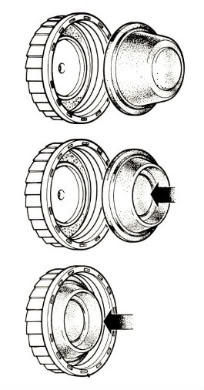When I bought my '75 MK III a month or so ago the front brake was essentially non-existent, so I did the madass resleeve upgrade to the master cylinder, and sent the rotor off for grinding and drilling. When I reassembled it all I thought for a while it wasn't going to work, because I wasn't having any luck getting any pressure at the brake lever. But I kept at it and finally got it bled, and it felt pretty good. I also installed new Ferodo Platinum pads, and when I had the caliper off it appeared that the pistons in the caliper were new.
But now it seems that I keep having less and less free play at the brake lever, and at the end of my ride today I had very little play in the brake lever, and it seems that the brake is beginning to bind without even applying the lever. Any ideas what the cause of that might be? Maybe an issue with the caliper? Or could it be possible that I overfilled the reservoir?
One other issue that I wonder about is that when I was bleeding the system, I had to do it by pumping the piston by hand with the brake lever off, because with the lever in place the piston seemed to not be able to extend far enough to get any fluid movement in the reservoir. In other words, when I pumped it by hand I would see the little jet of fluid in the reservoir, but with the lever on the internal piston spring appeared unable to extend the piston far enough to make that happen. I thought that was odd, but forgot about when I finally got the brake working well. Now I'm wondering if the brake lever isn't allowing the brake pressure to release fully, and it is incrementally not allowing the brake pads to retract when the lever is released?
But now it seems that I keep having less and less free play at the brake lever, and at the end of my ride today I had very little play in the brake lever, and it seems that the brake is beginning to bind without even applying the lever. Any ideas what the cause of that might be? Maybe an issue with the caliper? Or could it be possible that I overfilled the reservoir?
One other issue that I wonder about is that when I was bleeding the system, I had to do it by pumping the piston by hand with the brake lever off, because with the lever in place the piston seemed to not be able to extend far enough to get any fluid movement in the reservoir. In other words, when I pumped it by hand I would see the little jet of fluid in the reservoir, but with the lever on the internal piston spring appeared unable to extend the piston far enough to make that happen. I thought that was odd, but forgot about when I finally got the brake working well. Now I'm wondering if the brake lever isn't allowing the brake pressure to release fully, and it is incrementally not allowing the brake pads to retract when the lever is released?

